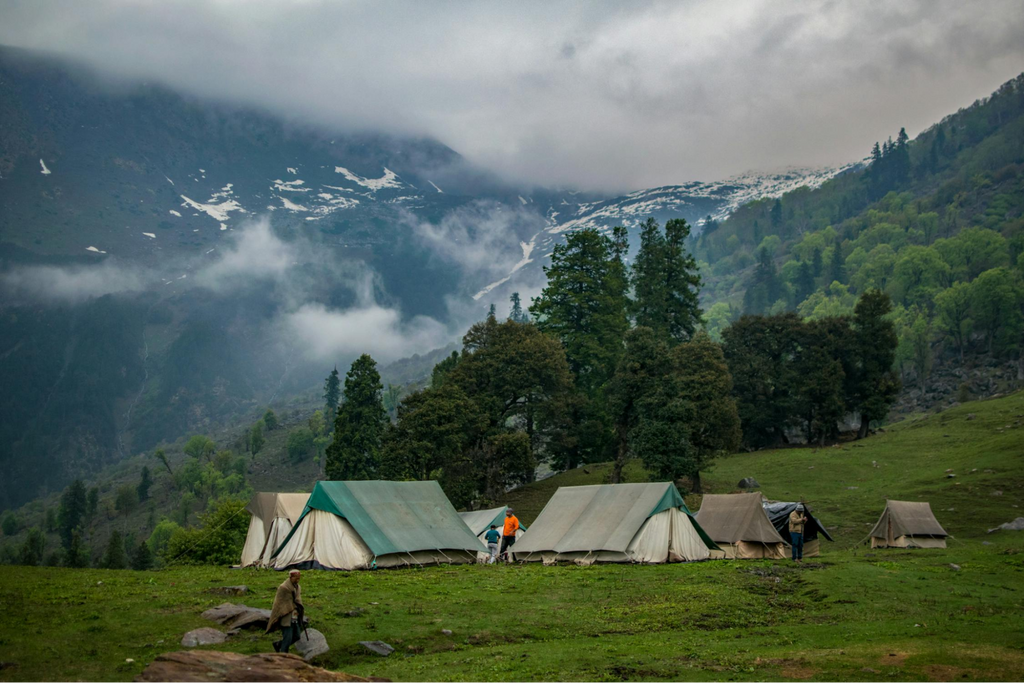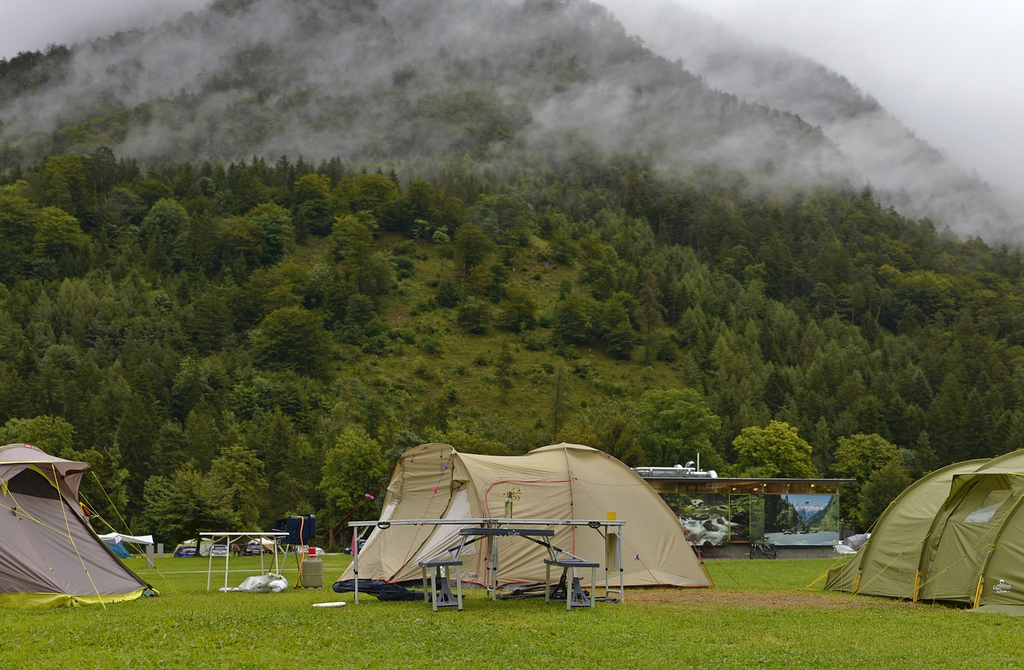With summer just around the corner, you must have considered camping in the woods. You may have contemplated going on a scenic hike, relaxing at a lakeside, or cooking delicious meals by the fire. But what do you do when the weather has other plans?
Your worry is understandable. Camping in the rain can seem daunting and discouraging, even for experienced enthusiasts. Spontaneous rain, one that is not already prepped for, can make the situation worse.
Although seemingly dangerous, camping in the rain can become a memorable and joyful trip if you prepare beforehand and pack the right gear for it.
Our guide covers the know-how of every minute detail you need to keep in mind, with excellent product recommendations to make your stay as comfortable and enjoyable as possible.
What Do You Need for Camping in the Rain?

Preparation beforehand is the most essential element of camping in the rain. Without adequate gear, your trip can easily take a road downhill. You must invest in these recommendations to enhance the quality and drive contentment from your endeavor. Take pen and paper, and let’s get started!
- Pack a Rain Jacket
Now, this may seem like common sense. Who wouldn't prepare for the worst? Yet the majority overlook this step easily in their overjoyed attempts to focus on the latter half of the trip.
Packing sufficiently and strategically is equally important to ensure your trip runs smoothly. You may want to keep extra layers of clothing in case you soak often.
- Don’t Forget Waterproof Shoes
Most people detest getting their shoes wet, even more so than their clothing. Understandably, wet shoes take twice as long to dry and reuse, which can be a hassle. Pack extra pairs of shoes, preferably waterproof, to avoid possible inconvenience.
- Waterproof Tent
You may want to invest in a high-quality, waterproof tent that provides adequate protection against the rain.
When looking for waterproof tents, consider purchasing tents with water-resistant rainfly and sealed seams for added protection against downpours.
- Line the Inside and Outside of Your Tent
Although placing a groundsheet on the ground can reduce the amount of water that seeps in from the ground, the risk is nevertheless present.
To solve this problem, consider lining your tent from the inside. First, grab hold of the thick plastic sheet used by workers for construction. Then, cut a piece off that is approximately six inches wider than the diameter of your tent. Place this piece inside as an added layer of defense.
To shield your tent externally, place an overhanging protection tarp. This tarp will allow you a little more space beyond your tent, almost mimicking a front porch, to keep extra material/clothing.
- Bring an Extra Supply of Plastic Bags
Big plastic bags (garbage bags), along with zip-lock bags, can come in handy in multiple ways when camping in the rain while taking up minimal space in your luggage.
You can use these to store both dry and wet items, such as firewood and wet clothing. The Ziplock bags can be used to keep your packed clothing and accessories safe and protected against the downpour.
- Portable Power Station
Carrying a portable power station is an excellent way to cater to all your power-related needs. You need a product that can withstand harsh, rainy conditions while providing optimal and maximum benefit.
Making use of technology can make your journey tenfold easier. Consider buying a model that is smart and portable. Check out the best Portable Power Station to Purchase for your next camping trip.
Compared to the portable power stations available on the market, the following portable power station by BLUETTI fits your criteria perfectly for camping in the rain.
BLUETTI AC240 Portable Power Station

The BLUETTI AC240 Portable Power Station is a remarkable innovation for those who love a flexible and smart product for camping and other needs. Let’s take a look at some of the key features that make this product a perfect companion to all your outdoor escapades.
Key Features:
Dust and Water Resistant: The product has been tested rigorously to meet the IP65 criteria. Hence, the product ensures durability and can be used in all outdoor excursions without risk.
Power Output: The device has the potential to deliver up to 2,400W of uninterrupted AC output. Additionally, it offers an increase in output to 3,600W by enabling the powerlifting mode.
Scalability: The product’s capacity can be expanded up to 10,136Wh by adding four B210 batteries. This will enable you to adjust the power capacity of the product depending on your needs.
Recharging: The product has a fast recharging capability. In 45 minutes, you can charge it from 0-80%, with a 2,200 watt AC input.
Parallel Connection: With a maximum output of 4800 watts and 120 volts, buyers can extend the capacity to 20,272 watt-hours and connect multiple units of this product simultaneously.
With a maximum solar input of 1200 watts, the BlUETTI AC240 Portable Power Station provides an excellent product that combines the best user-targeted features and will make your next camping excavation much more fun!
Check out a detailed review of the BLUETTI AC240 Portable Power Station:
Is It a Good Idea to Camp in the Rain?
Camping in the rain is a one-of-a-kind experience. It is equally rewarding and memorable. However, it requires a combined basic level of expertise and knowledge. Consider the following factors before planning your trip.
- Preparation: As we discussed, your trip can lean towards either side of the two extremes based on your level of preparation. Waterproof clothing and tents are some of the basic components.
- Expertise: If you have never experienced camping in the rain, you may want to do some extra research and learn about the subject. Consider taking advice from someone who has.
- Location: Choosing a relatively safer location and terrain for your camping spot is essential to the quality of your overall decision. Avoid camping in areas that are more prone to flooding and or have a slippery slope.
- Mindset: As with everything else in life, the decision to go camping in the rain will boil down to your mindset and overall approach. Maintaining a positive mindset is crucial to the enjoyment derived from the trip.
Whether camping in the rain is a good idea for you will reduce itself to personal preference, level of expertise, knowledge, and certain choices you make along the way. Make sure to go through our product recommendations to make decision-making easier.
This is an essential camping checklist for a weekend outdoors to consider before setting out for your camping trip.
Is It Safe to Camp Out at Night in the Rain?

Camping at night can be a little more challenging, especially when it rains. You might have to take additional measures to make your experience safe and smooth. Consider the following factors when camping at night in the rain.
- Location: Opt for a location that is less prone to flooding and offers good drainage to eliminate risks at night.
- Tent: Your tent must be water resistant and well set up so you do not have to fix it at night if it rains.
- Tools and Equipment: Pack flashlights and sleeping gear to reduce any possible risk of trouble at night
- Emeergnecy Supplies: Don't forget to pack emergency supplies, including medicines, first aid kit, emergency shelter, etc.
Although the precautions mentioned previously can ensure safety, you may want to talk to people who have had a similar experience. If the weather forecast is consulted beforehand and the location is chosen wisely, it will be safe to camp out at night in the rain.
Tips for Camping in the Rain

Besides packing strategically and sufficiently for your camping adventure, we have gathered and grouped additional tips to help aid your research.
- Weather Forcast: Take notes on the number of days you’d spend at the camping site, including temperature and rain probability. Frequently double-check the weather forecast for possible changes that might affect your decisions.
- Avoid Packing Cotton Clothing: Refrain from bringing in clothing made of cotton material, as it absorbs humidity and takes longer to dry. Consider packing nylon and lightweight materials that do not hold onto moisture.
- Fire-starters: It will be close to impossible and extremely frustrating to start a wire with wet wood and soggy match sticks. Remember to bring extra firestarters so you do not shiver in the cold!
- Clothesline: Carry and hang a clothesline to dry your clothes faster. It is lightweight and can be used inside or outside your tent, depending on the weather conditions.
- Shoes: Pack shoes that are waterproof and have good traction to avoid slipping and eliminate the possible risk of injury.
- Dry your Gear: Before you depart and after you return home, make sure to dry your camping gear properly, especially the tent. Clean it and shake any leftover water off of the tent before using it.
- Plan Other Activities: In addition to watching the rain and taking in the scenic view, carry books, board games, or any other activity of your choice, as the rain period might extend longer than expected.
Enjoy Your Camping
The most important trick for making camping in the rain exciting and unforgettable is to stay positive and enjoy each moment to the fullest.
Chances are that some things might not go as planned even after you prepare well. Therefore, it is essential that you stay calm and present in the moment to figure out the best possible solution,
Relax, reflect, and take in the rhythmic quality of the rain, along with the enticing scent and scenic landscape. Embrace every minor inconvenience as part of the experience. Take this opportunity to spend more time with yourself and the people around you.
Most of all, you will learn skills that will help you throughout your life!







































































